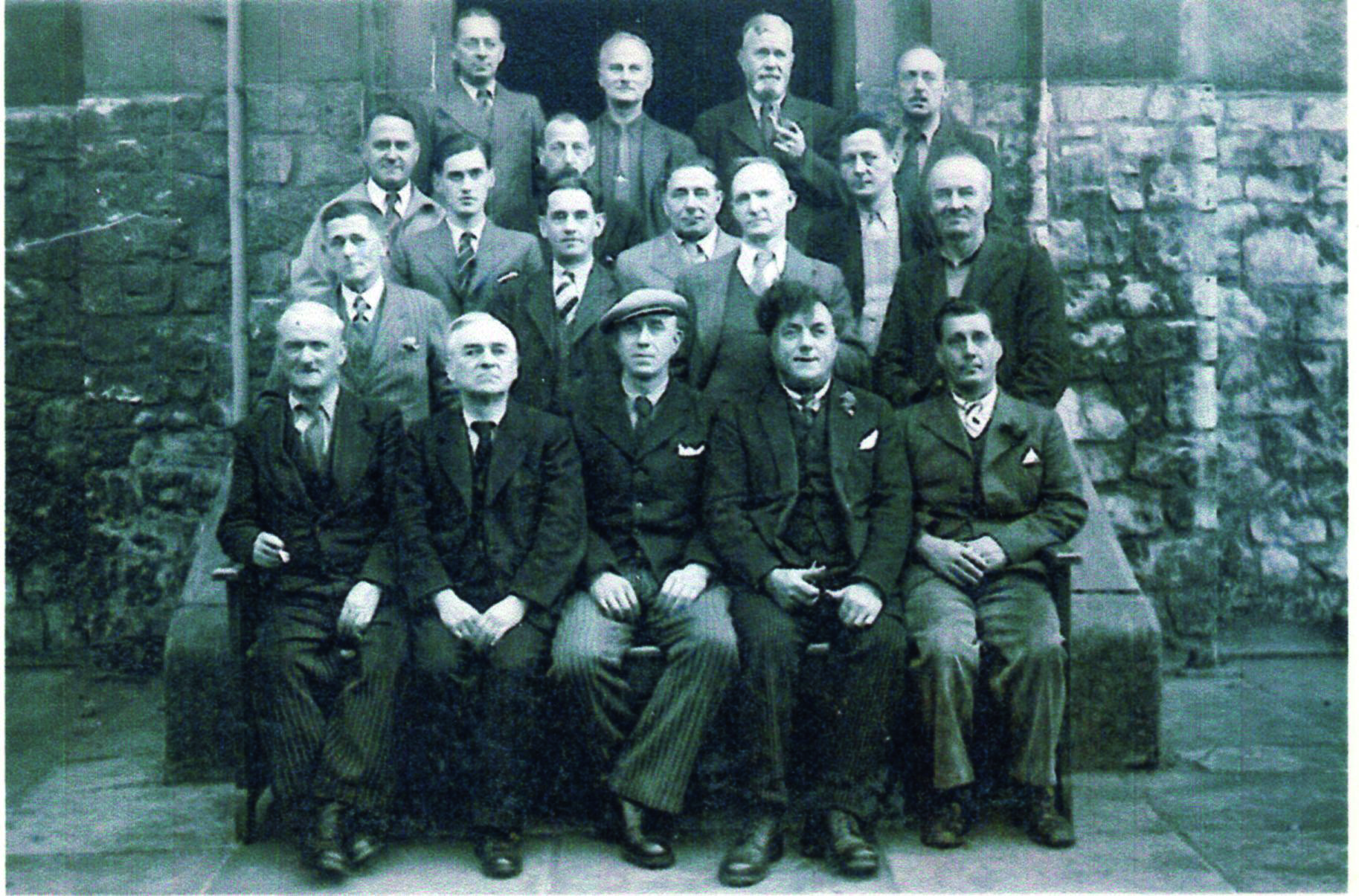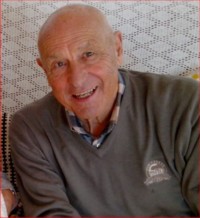Reginald George Rainey and Tom Sarginson internees at Ilag VIII Tost and Giromagny 1940-1945

 This blog and Bill Forster's book and memories of Calais at the beginning of World War II, led to our being contacted by descendants of Reginald George Rainey (*) and Tom Sarginson (**). Rainey appears on the photo of internees at Tost Ilag8. He is first left on second row from top [link]. The descendants are Rainey's grandson and great nephew. Sarginson appears on this photo first left of the top row. I am reproducing below freely adapted extracts of email conversations with them (italics are mine).
This blog and Bill Forster's book and memories of Calais at the beginning of World War II, led to our being contacted by descendants of Reginald George Rainey (*) and Tom Sarginson (**). Rainey appears on the photo of internees at Tost Ilag8. He is first left on second row from top [link]. The descendants are Rainey's grandson and great nephew. Sarginson appears on this photo first left of the top row. I am reproducing below freely adapted extracts of email conversations with them (italics are mine).
(*) Rainey worked for Brampton chains (**) Sarginson worked for Courtaulds (les filés de Calais). I told his story previously in the blog tnaks to his daughter Jeane Gask [link to it].
From Peter Blagoyevich grand nephew of Reginald George Rainey: Here is a picture of Uncle George (Reginald George Rainey). Here is a postcard of his 1st wife Fernande Towlson who was interned in Vittel by the Nazis [link]. The rear of the post card is included with a reference to Uncle George and ILAG VIII [link]. Their daughter Kate Molly Rainey was born in August 1921. She married Zoran Blagoyevich (a Serb); they emigrated to the United States.
I have spoken to my cousin Philip Blagoyevich who may well get in touch with you as he is George's grandson. He said George and his brother-in-law Arthur Towlson (*) were both caught by the Germans in Calais and remained interned until 1945 when they were released. Arthur Towlson unfortunately committed suicide not long after.
I have also included the 1911 census with George's siblings [link]. Harry and Arthur also served in WW1.
As you can see he made the rank of Sergeant in the R.A.O.C. in WW1 as shown on his medal card [link].
(*) His first name was in fact Edward, not Arthur; this is a mistake that has led to confusing this Edward Towlson interned at Tost with another Edward Towlson, probably the first Towlson namesake who came to Calais after the napoleonic wars in the wake of the industrial revolution and the start of the lace industry in Calais. More on this later.
From Philip Blagoyevich grandson of Reginald George Rainey to Jeanne Gask, daughter of Tom Sarginson: Dear Jeanne,
It is very exciting to hear your story and to see the Photo, and I'll be happy to add another book (yours) to my collection! That is indeed my
Grandfather, Reginald George Rainey, in the middle. He told us of his WWI and WWII experiences. I was not aware of the Wodehouse connection however.
I'm afraid I do not know the others in the photo. Best regards. Philip Blagoyevich Date: Wed, 29 Apr 2015 10:46:31 +0100
From Jeanne Gask daughter of Tom Sarginson to Peter Blagoyevich: Dear Peter. I am the daughter of Tom Sarginson (top left in photo). Reginald Rainey was a good friend of Tom's both in the Calais days and at Tost. I remember his name from the Calais days when I was a child. A group of Calais men, all friends, tried to stay together. They were in the same dormitory and eight of them ate at the same table. Tom Sarginson, George Gregson, Sandy Yull (our Calais neighbour), Reginald Rainey, Mr. Pickard, etc.
The author P.G. Wodehouse joined them for a short while. I enclose another photo, I think that's Reg Rainey in the middle, I don't know who the others are. You may be interested to know that my book "Nell and the girls" by Jeanne Gask (Myrmidon Press) is appearing in a week's time. It tells of my English mother's difficult life raising three children in occupied France, all seen from a child's point of view, it also describes a little of my Dad Tom's life in internment. If you are interested, the book is available on Amazon.
Kind regards, Jeanne Gask. 2015-04-28 19:52 GMT+01:00 Philip Blagoyevich :>
Arthur Towlson a namesake of Rainey's brother in law!
 I am publishing this link because one has to be careful with first names and family names! The Towlsons descending from Edward Towlson who came to Calais in 1826 at the beginning of the lace industry from Nottingham, became French as the generations passed. There are many Towlsons in Calais region today. When I was in Calais I knew a Pierre Towlson; he was the son of an insurance brocker. You may find this photo of Pierre Towlson at the Pensionnat Saint-Pierre in 1946 just below me to my right (I'm under the arrow).
I am publishing this link because one has to be careful with first names and family names! The Towlsons descending from Edward Towlson who came to Calais in 1826 at the beginning of the lace industry from Nottingham, became French as the generations passed. There are many Towlsons in Calais region today. When I was in Calais I knew a Pierre Towlson; he was the son of an insurance brocker. You may find this photo of Pierre Towlson at the Pensionnat Saint-Pierre in 1946 just below me to my right (I'm under the arrow).
The Edward Towlson who was interned in Tost was surely a namesake of the first Edward Towlson who emigrated to Calais [see genealogy of Towlsons]. You may find many references on the genealogy of the early Towlson who came to Calais See UK Census research: familiy name Towlson.
Now for Bill Forster; he is questioning why the British community in Calais, let me say the English and Welsh as I know, didn't continue after WWII. I think it is a matter of circumstances.
First of all, let it be reminded that France and Britain have always been close throughout history. From the Romans, the middle ages and feudality, the Normans, the hundred years war, the renaissance, the enlightenment, the industrial revolution.... The language, institutional and cultural differences are probably more recent; from the Glorious Revolution in Britain 1688 and the French revolution in 1789 and Edmund Burke's reflexions. But the relationship was always great and links developed in particular circumstances. Old english names are frequent in the Pas de Calais, nearest to England.
In more recent times ie. after the napoleonic wars, I find three waves of Englishmen who immigrated in France. After the wars and the blockade of Napoleon, there was a high degree of poverty in England. The industrial revolution gave opportunities for exports of machinery for producing fabrics, of which lace that was until then a luxury good for the very rich. This is how the lace industry started in Calais from circa 1826. Engineers and machines were imported to Calais, the latter by smuggling. All the englishmen and families who came to Calais in those days became French as the generations passed. Their names are still there today: Boot, Young, West, Hurst, Austin...
A second wave came with the production of coal after the Cobden-Chevallier trade agreement between Britain and France in 1864. This was the time my ancestors came; a story I have told here.
The third wave came with WWI when british soldiers who fought the war stayed in France after the war, married French girls and founded families. It was mainly these "tommies" who were arrested in July 1940 and interned because Britain remained at war with Germany. That is the story of Gregson, Rainey, Towlson and most of the 623 internees listed by Frederick Turner, including his father. Also Davies a welshman, who created the Normandy Hotel in Wissant still owned by his descendants.
My uncle Harold was interned at Tost. Born in 1895, Harold was the son of Allen William Ratcliffe who had come to Calais as a young engineer with his wife in 1889, as manager of a coal import depot of the Altofts coal mine in the West Riding of Yorkshire. The sons of Allen William and Ann Martin his spouse, opted for British nationality when they were 18. They enrolled in the British army in the recruitment scheme organised by Lord Kitchener. The boys were brought to believe the war would be a matter for a few weeks and that the power of the British Empire would defeat Germany swiftly. Kitchener: recruitment to the British army in World War One.
Everyone has a story. The mix of those stories, in their circumstances, are the fabric of society, today, yesterday and tomorrow. We all depend on society, its language, its institutions and its ways of behaving. We share all the products and services that we produce collectively. Today in 2015, circumstances are different from those that prevailed in 1940. There are more opportunities for activity and good jobs in Britain. So many French men and women go to the UK.
- Edmund Burke: reflexions on the French revolution
- Edmund Burke : réformer sans détruire VALÉRY GISCARD D'ESTAING 1997
- My family history related to the Altofts coal mine in the West Riding of Yorkshire
- History of lace making in Calais
- Cobden-Chevallier treaty 1860
- Kitchener: recruitment to the British army in World War One
- UK Census research: name Towlson
- "Nell and the girls" by Jeanne Gask (Myrmidon Press)
- The Glorious Revolution in Britain 1688
- The French revolution in 1789
- Old english names are frequent in the Pas de Calais, nearest to England.
- Linguistic culture of English Calais
- My website pages dedicated to Calais and its history
- The story of Tom Sarginson internee at Tost 1940-1945
Mis en ligne le 04/05/2015  pratclif.com
pratclif.com

 This blog and Bill Forster's book and memories of Calais at the beginning of World War II, led to our being contacted by descendants of Reginald George Rainey (*) and Tom Sarginson (**). Rainey appears on the photo of internees at Tost Ilag8. He is first left on second row from top [link]. The descendants are Rainey's grandson and great nephew. Sarginson appears on this photo first left of the top row. I am reproducing below freely adapted extracts of email conversations with them (italics are mine).
This blog and Bill Forster's book and memories of Calais at the beginning of World War II, led to our being contacted by descendants of Reginald George Rainey (*) and Tom Sarginson (**). Rainey appears on the photo of internees at Tost Ilag8. He is first left on second row from top [link]. The descendants are Rainey's grandson and great nephew. Sarginson appears on this photo first left of the top row. I am reproducing below freely adapted extracts of email conversations with them (italics are mine).